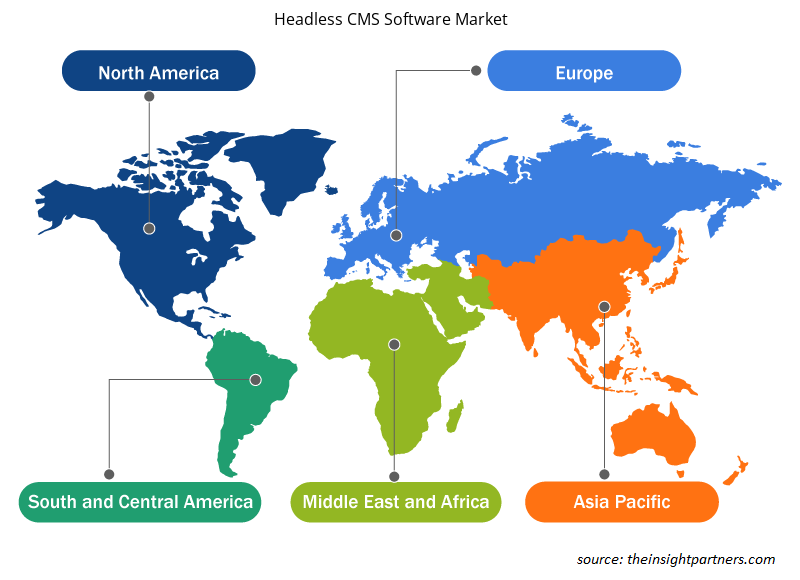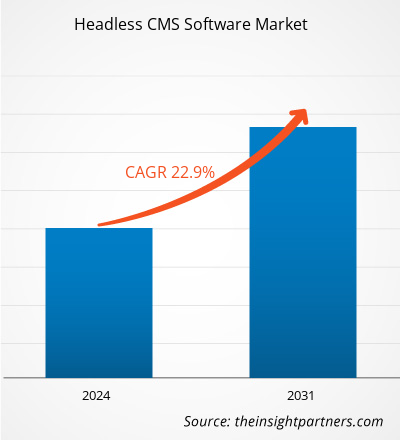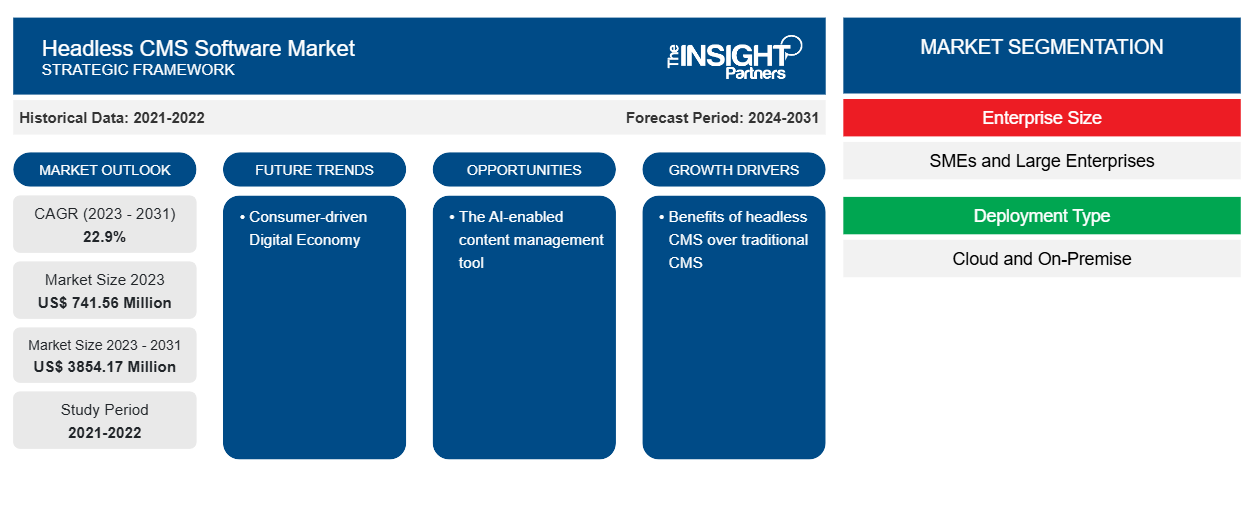Se prevé que el tamaño del mercado de software CMS sin interfaz gráfica alcance los 3854,17 millones de dólares en 2031, frente a los 741,56 millones de dólares en 2023. Se espera que el mercado registre una CAGR del 22,9 % entre 2023 y 2031. Es probable que el rápido crecimiento del contenido digital y la adopción de tecnologías basadas en la nube sigan siendo claves para las tendencias del mercado de software CMS sin interfaz gráfica.
Análisis del mercado de software CMS sin interfaz gráfica
La adopción de software CMS sin interfaz gráfica mejora la seguridad y el rendimiento, y puede promover la flexibilidad, la escalabilidad y la localización. Este factor impulsa el mercado de software CMS sin interfaz gráfica. La demanda de CMS sin interfaz gráfica en diversas industrias en países desarrollados y en desarrollo impulsa su crecimiento en el mercado.
Descripción general del mercado de software CMS sin interfaz gráfica
Un CMS sin interfaz gráfica es un sistema de gestión de contenido que permite separar el frontend del backend. En esta arquitectura, un CMS funciona como un repositorio de contenido y el contenido se puede implementar en múltiples plataformas a través de una API. Uno de los principales beneficios de un CMS sin interfaz gráfica es su flexibilidad. Con un CMS tradicional, el frontend y el backend están inextricablemente vinculados, por lo que los cambios en el frontend afectan los cambios en el backend y viceversa. Con un CMS sin interfaz gráfica, el backend está separado del frontend, lo que permite a las empresas cambiar su contenido y aplicaciones en el frontend sin afectar al backend.
Personalice este informe según sus necesidades
Obtendrá personalización en cualquier informe, sin cargo, incluidas partes de este informe o análisis a nivel de país, paquete de datos de Excel, así como también grandes ofertas y descuentos para empresas emergentes y universidades.
- Obtenga las principales tendencias clave del mercado de este informe.Esta muestra GRATUITA incluirá análisis de datos, desde tendencias del mercado hasta estimaciones y pronósticos.
Factores impulsores y oportunidades del mercado del software CMS sin interfaz gráfica
La economía digital impulsada por el consumidor favorecerá al mercado
La economía digital impulsada por el consumidor se ha convertido en el componente fundamental de las estrategias de comercio digital en todas las industrias. El consumidor llega a las empresas o marcas a través de varios canales. Esto alienta a las empresas a modernizar su estrategia de experiencia digital para ofrecer verdaderas experiencias omnicanal que satisfagan las demandas de personalización de los clientes. El contenido centrado en el cliente debe ser personalizado, dinámico y entregado a gran velocidad. Con los beneficios de la agilidad, la flexibilidad, la escalabilidad y la personalización, el software CMS sin interfaz gráfica puede ayudar a las empresas a mejorar la experiencia del cliente.
Beneficios de un CMS sin interfaz gráfica frente a un CMS tradicional
Un CMS sin interfaz gráfica ofrece una mayor flexibilidad que un CMS tradicional, ya que con un CMS sin interfaz gráfica, el contenido debe crearse una sola vez. Se puede distribuir a múltiples canales y dispositivos, incluidos sitios web, relojes inteligentes, aplicaciones móviles, dispositivos IoT y otros. Un CMS sin interfaz gráfica distribuye contenido a través de API donde las páginas se cargan a mayor velocidad y de manera más eficiente, mientras que con un CMS tradicional, cada página requiere activar una renderización del lado del servidor, lo que provoca un tiempo de carga lento. Un CMS sin interfaz gráfica es más seguro que un CMS tradicional, ya que utiliza tecnologías avanzadas nativas de la nube y no expone el servidor backend a Internet. Por lo tanto, estos diversos beneficios del CMS sin interfaz gráfica sobre el CMS tradicional conducen al crecimiento del mercado de software CMS sin interfaz gráfica.CMS offers greater flexibility over traditional CMS, as with the headless CMS, the content needs to be created once. It can be distributed to multiple channels and devices, including websites, smartwatches, mobile apps, devicesCMS delivers content via APIs where the pages load at a greater speed more efficiently, whereas with the traditional CMS, each page requires trigger a server-side-render, which causes slow load time. Headless CMS is more secure than traditional CMS as they use advanced cloud-native technologies and they don’t expose the backend server to the internet. Thus, such several benefits of headless CMS over traditional CMS lead to the headless CMS software market growth.
Análisis de segmentación del informe de mercado de software CMS sin interfaz gráfica
Los segmentos clave que contribuyeron a la derivación del análisis del mercado de software CMS sin cabeza son la implementación de tinta, el tamaño de la organización, el tipo de monitoreo y la industria.
- Por implementación, el mercado se segmenta en local y en la nube. Se espera que el segmento de la nube crezca con la CAGR más alta.
- En función del tamaño de la empresa, el mercado se segmenta en pymes y grandes empresas. Se espera que el segmento de pymes crezca con la CAGR más alta.
Análisis de la cuota de mercado del software CMS sin interfaz gráfica por geografía
El alcance geográfico del informe de mercado de software CMS sin cabeza se divide principalmente en cinco regiones: América del Norte, Asia Pacífico, Europa, Medio Oriente y África, y América del Sur/América del Sur y Central.
Se espera que la región de Asia Pacífico crezca con la CAGR más alta. La proliferación de la tecnología en la nube en la región conduce al crecimiento del mercado de la región. El crecimiento de las PYME en la región impulsa la demanda de soluciones de software en la región, impulsando el uso de la tecnología de monitoreo sintético . La transformación digital en economías emergentes como India y China conduce a la adopción de soluciones de monitoreo sintético en varias industrias de usuarios finales.
Perspectivas regionales del mercado de software CMS sin interfaz gráfica
Los analistas de Insight Partners explicaron en detalle las tendencias y los factores regionales que influyen en el mercado de software CMS sin interfaz gráfica durante el período de pronóstico. Esta sección también analiza los segmentos y la geografía del mercado de software CMS sin interfaz gráfica en América del Norte, Europa, Asia Pacífico, Oriente Medio y África, y América del Sur y Central.

- Obtenga datos regionales específicos para el mercado de software CMS sin interfaz gráfica
Alcance del informe de mercado del software CMS sin interfaz gráfica
| Atributo del informe | Detalles |
|---|---|
| Tamaño del mercado en 2023 | US$ 741,56 millones |
| Tamaño del mercado en 2031 | US$ 3854,17 millones |
| CAGR global (2023 - 2031) | 22,9% |
| Datos históricos | 2021-2022 |
| Período de pronóstico | 2024-2031 |
| Segmentos cubiertos | Por tamaño de empresa
|
| Regiones y países cubiertos | América del norte
|
| Líderes del mercado y perfiles de empresas clave |
|
Densidad de actores del mercado de software CMS sin interfaz gráfica: comprensión de su impacto en la dinámica empresarial
El mercado de software CMS sin interfaz gráfica está creciendo rápidamente, impulsado por la creciente demanda de los usuarios finales debido a factores como la evolución de las preferencias de los consumidores, los avances tecnológicos y una mayor conciencia de los beneficios del producto. A medida que aumenta la demanda, las empresas amplían sus ofertas, innovan para satisfacer las necesidades de los consumidores y aprovechan las tendencias emergentes, lo que impulsa aún más el crecimiento del mercado.
La densidad de actores del mercado se refiere a la distribución de las empresas o firmas que operan dentro de un mercado o industria en particular. Indica cuántos competidores (actores del mercado) están presentes en un espacio de mercado determinado en relación con su tamaño o valor total de mercado.
Las principales empresas que operan en el mercado de software CMS sin interfaz gráfica son:
- Agilidad Inc.
- Mantequilla CMS
- Contentful GmbH
- ContenidoStack Inc.
- dotCMS LLC
- Hygraph GmbH
Descargo de responsabilidad : Las empresas enumeradas anteriormente no están clasificadas en ningún orden particular.

- Obtenga una descripción general de los principales actores clave del mercado de software Headless CMS
Noticias y desarrollos recientes del mercado de software CMS sin interfaz gráfica
El mercado de software CMS sin interfaz gráfica se evalúa mediante la recopilación de datos cualitativos y cuantitativos a partir de una investigación primaria y secundaria, que incluye publicaciones corporativas importantes, datos de asociaciones y bases de datos. A continuación, se incluye una lista de los avances del mercado:
- En junio de 2023, aurastride, la última incorporación a la oferta de productos de Vsourz, tiene como objetivo revolucionar la industria de los viajes con su lanzamiento como una plataforma CMS headless de vanguardia. Esta solución innovadora está destinada a transformar la forma en que las empresas de viajes gestionan el contenido y ofrecen experiencias personalizadas, al tiempo que ofrece una integración perfecta con la aclamada plataforma SAAS para la industria de viajes moonstride. (Fuente: moonstride, comunicado de prensa, 2023)
Informe sobre el mercado de software CMS sin interfaz gráfica de usuario y resultados
El informe “Tamaño y pronóstico del mercado del software CMS sin cabeza (2021-2031)” proporciona un análisis detallado del mercado que cubre las siguientes áreas:
- Tamaño del mercado y pronóstico a nivel global, regional y nacional para todos los segmentos clave del mercado cubiertos bajo el alcance
- Dinámica del mercado, como impulsores, restricciones y oportunidades clave
- Principales tendencias futuras
- Análisis detallado de las cinco fuerzas de Porter y PEST y FODA
- Análisis del mercado global y regional que cubre las tendencias clave del mercado, los principales actores, las regulaciones y los desarrollos recientes del mercado.
- Análisis del panorama de la industria y de la competencia que abarca la concentración del mercado, el análisis de mapas de calor, los actores destacados y los desarrollos recientes
- Perfiles detallados de empresas
- Análisis histórico (2 años), año base, pronóstico (7 años) con CAGR
- Análisis PEST y FODA
- Tamaño del mercado, valor/volumen: global, regional y nacional
- Industria y panorama competitivo
- Conjunto de datos de Excel
Informes recientes
Informes relacionados
Testimonios
Razón para comprar
- Toma de decisiones informada
- Comprensión de la dinámica del mercado
- Análisis competitivo
- Información sobre clientes
- Pronósticos del mercado
- Mitigación de riesgos
- Planificación estratégica
- Justificación de la inversión
- Identificación de mercados emergentes
- Mejora de las estrategias de marketing
- Impulso de la eficiencia operativa
- Alineación con las tendencias regulatorias





















 Obtenga una muestra gratuita para - Mercado de software CMS sin cabeza
Obtenga una muestra gratuita para - Mercado de software CMS sin cabeza